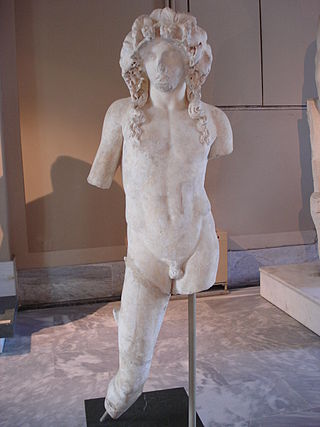Pope Agapetus I was the bishop of Rome from 13 May 535 to his death. His father, Gordianus, was a priest in Rome and he may have been related to two popes, Felix III and Gregory I.

Pope Agapetus II was the bishop of Rome and ruler of the Papal States from 10 May 946 to his death. A nominee of the princeps of Rome, Alberic II of Spoleto, his pontificate occurred during the period known as the Saeculum obscurum.

Menas (Minas) considered a saint in the Calcedonian affirming church and by extension both the Eastern Orthodox Church and Roman Catholic Church of our times, was born in Alexandria, and enters the records in high ecclesiastical office as presbyter and director of the Hospital of Sampson in Constantinople, where tradition has him linked to Saint Sampson directly, and in the healing of Justinian from the bubonic plague in 542. He was appointed Patriarch of Constantinople by the Byzantine emperor Justinian I on 13 March 536. Pope Agapetus I consecrated him to succeed Anthimus, who was condemned as a monophysite. This was the first time that a Roman Pope consecrated a Patriarch of Constantinople.
Anthimus I was a Miaphysite patriarch of Constantinople from 535–536. He was the bishop or archbishop of Trebizond before accession to the Constantinople see. He was deposed by Pope Agapetus I for adhering to Monophysitism before March 13, 536, and later hidden by Theodora in her quarters for 12 years, until her death.
Agapetus has been the papal name of two popes of the Roman Catholic Church.
Agapetus was a deacon of the church of Hagia Sophia at Constantinople. He was a reputed tutor of Justinian, and author of a series of exhortations in seventy-two short chapters addressed around 527 to Justinian.
Saint Agapitus may refer to:

Synnada was an ancient town of Phrygia Salutaris in Asia Minor. Its site is now occupied by the modern Turkish town of Şuhut, in Afyonkarahisar Province.

Agapetus of the Kiev Caves or Agapetus of Pechersk (born ?? - died 1095), was an Orthodox Christian saint and doctor, as well as a monk in Kiev Pechersk Lavra. He was born in Kiev and was taught and admitted to monastic vows by Saint Anthony of Kiev. Agapetus famously provided free medical services for poor people. He also healed grand prince Vladimir II Monomakh.
Agapetus was an ancient Greek physician, whose remedy for the gout is mentioned with approbation by Alexander of Tralles and Paul of Aegina. He probably lived between the third and sixth centuries AD, or certainly not later, as Alexander of Tralles, by whom he is quoted, is supposed to have flourished about the beginning of the sixth century.
Nassarius agapetus is a species of sea snail, a marine gastropod mollusc in the family Nassariidae, the nassa mud snails or dog whelks.

Agapetus is a genus of little black caddisflies of the family Glossosomatidae. There are at least 210 described species in Agapetus.
Agapetus montanus is a species of Caddisfly. It is endemic to the north-western states of the United States of America.
Agapetus rossi is a species of little black caddisfly in the family Glossosomatidae. It is found in North America.
Anthomyia ochripes is a species of root-maggot fly in the family Anthomyiidae.
Spelobia ochripes is a species of lesser dung flies.
The Council of Constantinople was a conference of the endemic synod held in Constantinople, the capital of the Eastern Roman Empire, in May–June 536. It confirmed the deposition of the Patriarch Anthimus I of Constantinople and condemned three prominent anti-Chalcedonians living in Constantinople, causing the Emperor Justinian I to ban all four from the capital. The Council of Jerusalem held in September was convoked to condemn the same four as heretics. The condemned were the deposed Patriarch Severus of Antioch, the deposed Bishop Peter of Apamea and the monk Zoora.
Meshir 23 - Coptic Calendar - Meshir 25





